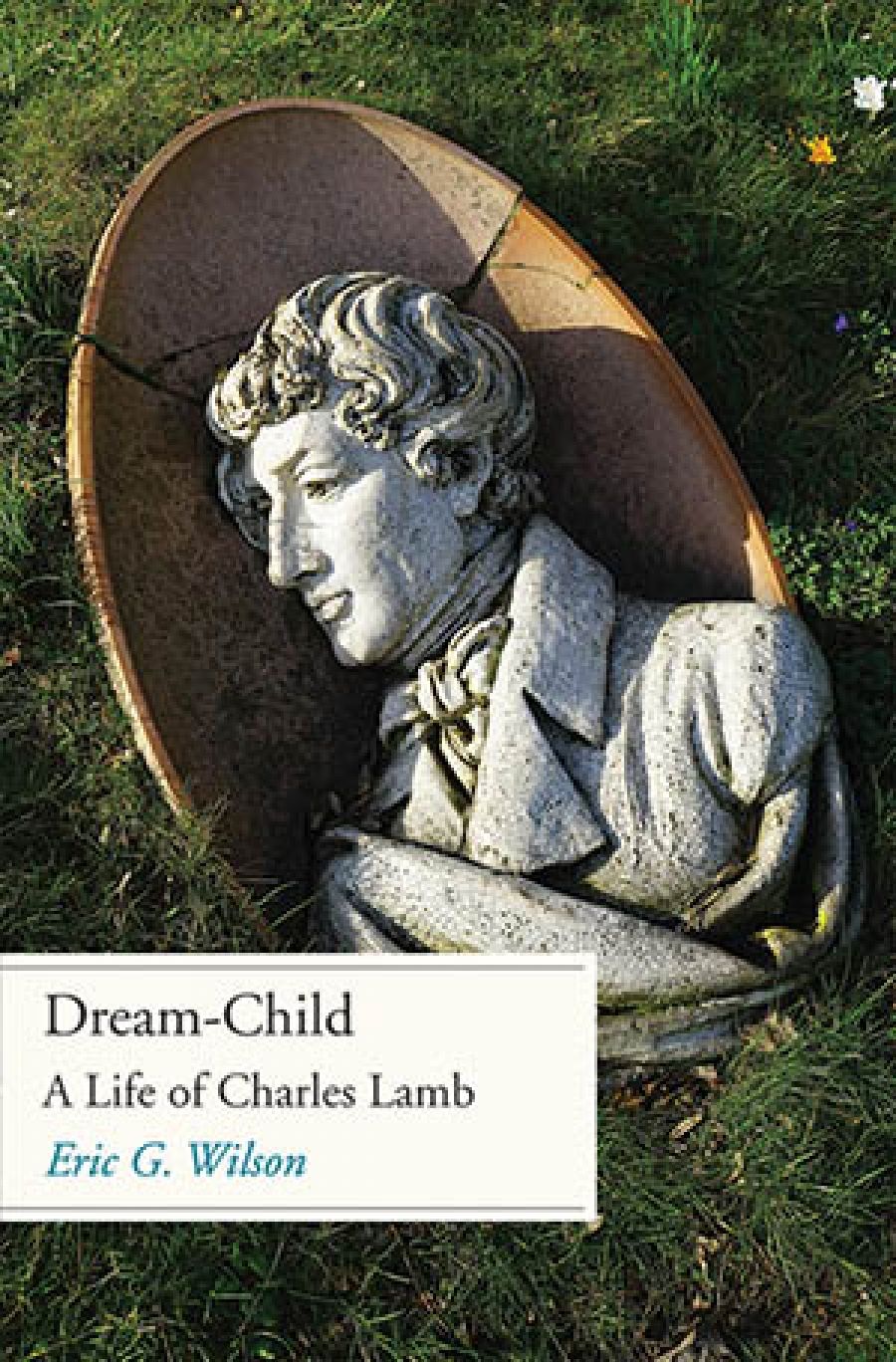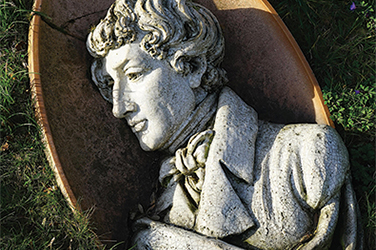
- Free Article: No
- Contents Category: Biography
- Review Article: Yes
- Article Title: The day of horrors
- Article Subtitle: Charles and Mary Lamb’s double-singleness
- Online Only: No
- Custom Highlight Text:
The life of Charles Lamb reads like a tale by Charles Dickens. In 1775, a sweet-natured boy is born in the Inns of Court, the ancient legal district in the city of London. The boy’s father, John Lamb, works as clerk, scribe, and all-round dogsbody for an imbecilic barrister called Samuel Salt – the names themselves are Dickensian – who does nothing without first consulting his servant. Charles, the youngest child by eleven years, grows up amid the great halls, libraries, chapels, staircases, sundials, fountains, and hidden orchards of the Inner Temple; his early youth is an Eden, but there is a serpent in the garden, because madness runs in the Lamb family.
- Featured Image (400px * 250px):

- Alt Tag (Featured Image): Frances Wilson reviews ‘Dream-Child: A life of Charles Lamb’ by Eric G. Wilson
- Book 1 Title: Dream-Child
- Book 1 Subtitle: A life of Charles Lamb
- Book 1 Biblio: Yale University Press, US$35 hb, 516 pp
His mother is chilly and aloof, but Charles is adored by his sister, Mary, who gives him the love she has been denied and teaches him to read from the encomia on the tombstones. Aged seven, he is wrenched from Mary’s arms to board at Christ’s Hospital, a charity school for the bright children of poor parents, and there he meets another dream-child called Samuel Coleridge, who will be his lifelong friend. Despite his academic promise, Lamb leaves school aged fourteen, by which point he has reached his full height of five foot nothing. He is not expected to enter the university: the boys who go to Oxford and Cambridge are those destined for the church, and Lamb can never preach because he stammers. He will therefore spend the next thirty-three years working in the Accountants office of East India House. Because he stammers he will also become a drunkard: a wit and a punster, Lamb can articulate his flow of ideas only when he is inebriated.
Aged twenty he writes poetry, frequents alehouses, falls in love, and spends six weeks in a madhouse in Hoxton. Lamb never has another episode of insanity, but on 22 September 1796 he returns home to find Mary in the kitchen, holding the bloody knife which she has just plunged into her mother’s heart; had he not wrested it from her, she would have wielded it on their father and aunt as well. The murder of his mother by his sister is the central event of Lamb’s life, although he will also once catch a swallow flying.
‘I date from the day of horrors,’ he tells Coleridge. The clocks now stop: nothing will ever happen to Lamb again. To save Mary from imprisonment in a lunatic asylum, he pledges to take care of her, and this is what he does. He is, after all, a child of the justice system. From now on, Charles and Mary Lamb ‘house together’, as he puts it, ‘old bachelor and maid, in a sort of double singleness’. William Wordsworth describes them similarly as ‘a double tree / with two collateral stems sprung from one root’. Despite wanting to, Lamb will not marry, because of Mary’s madness, and he will stay in the job he loathes in order to pay for her care. Every year or so, when she loses her mind, he will walk with her to the local asylum, her straitjacket over his arm, and then wait anxiously for her return. ‘I am a widow’d thing, now thou art gone,’ he writes when Mary is incarcerated. And every few years, the siblings will pack their books and Hogarth prints and move to a different part of London, where the neighbours do not know them. They once go as far north as Enfield, but it is not a success; neither cares for rural life.
Lamb lives for his sister and his friendships. He mourns when Coleridge abandons him for Wordsworth, but the Lambs befriend the Wordsworths too, and also William Godwin, William Hazlitt, and Mary Shelley. When Mary Lamb is sane, she and Charles host weekly dinners where he drunkenly recites ‘diddle diddle dumpling’. In his leisure time he discovers the English drama of the sixteenth century and writes about it in ‘Specimens of English Dramatic Writers who lived about the Time of Shakespeare’. He publishes a novel called Rosamund Gray (1798) and stages a play called ‘Mr H- ’, which is hissed by the audience. When he and Mary turn Shakespeare’s plots into tales for children, Lamb has his first success. The volume, say the critics, ‘stands unique … without rival or competitor’. Double-singleness works best as his literary style, and so Lamb invents a familiar called Elia who describes, in essays for The London Magazine, a whimsical version of Lamb’s life that does not contain the day of horrors. When he dies aged fifty-nine, after falling on his face in the street, Mary lives the last thirteen years of her life alone. It was better this way, for he could not have survived without her.
The version of this story told in Dream-Child is ‘darker’, says Eric G. Wilson, than Lamb’s earlier biographers have allowed. Wilson has no time for Coleridge’s ‘gentle-hearted Charles’ (‘the moniker Lamb most loathed’), or Wordsworth’s ‘gentle and frolic’ essayist. His own Lamb is a ‘bitter and desperate’ melancholic constrained by mind-forged manacles. A drunk, wrote Lamb in ‘Confessions of a Drunkard’, is ‘not a man with drink added. His very being is drink’, and this is the man described by Wilson. He replaces the dotty antiquarian with an alcoholic pioneer of autofiction, an anti-imperialist trapped in the cogs of Empire. ‘Imagine Jonathan Franzen,’ Wilson argues, ‘the passionate animal rights activist, writing ads for a drugs company experimenting on animals. Or David Foster Wallace, satirist of global capitalism, joining Google’s branding team.’ However unconvincing the analogies – Lamb’s ‘strangeness’ is also compared to that of David Lynch – Wilson’s reassessment of ‘St Charles’ (as William Thackeray called him) brims with gusto; this biography is alive all over.
Channelling the familiar style of Elia himself, the introduction is written in the second person: ‘You are walking westward … Look out! Coach-and-four!’ Several of the book’s paragraphs are enclosed in parenthesis, and Wilson shifts easily between present and past tense. He is more interested in Elia than in Lamb himself – or rather, he is interested in the ironic gap between Lamb and his persona – which makes Dream-Child a literary life in the fullest sense. Elia, which sounds like ‘a liar’, is also, explained Lamb, a ‘name without a meaning’. As Elia, Lamb indulged his love of theatrical comedy and seventeenth-century baroque, and his need for escape. Elia writes about ordinariness: the frictionless air of the South Sea offices, his happy childhood, his friends and relations, his love of the theatre and of old china teacups.
Wilson’s reading of the dynamic between the Lambs is surely right. In his version, Mary is the saviour of her brother rather than the other way round. ‘If Mary hadn’t done what she did, he might have passed through the portal of lunacy again. But after she killed he had to settle for smaller rebellions: gin, punning, poetry.’ Mary carried the madness for them both; this is how their double-singleness worked, and Charles added her sacrifice to his burden of guilt (which included his preference for his sister over his mother). ‘Their relationship is one of the most fascinating in all of literature,’ Wilson writes, ‘on a par with the interactions of the Brontë sisters.’ Would that he had developed this comparison further, or explored the Romantic sibling-love in more depth. In the Lake District – a place Lamb abhorred – Wordsworth was living in double-singleness with his own sister, Dorothy, who would herself go mad after he married; meanwhile, Byron had a child with his half-sister, and Coleridge routinely fell in love with the sisters of his friends’ wives. Sisters, in the Romantic circle, were almost akin to wives, and Lamb’s bond with Mary recalls what Elizabeth Hardwick said of Scott Fitzgerald and the schizophrenic Zelda: ‘the burden and his bearing of it were at the very centre of his moral being. It was his plot, his story, his symbol, image, destiny, obsession.’
Lamb’s essays, said Virginia Woolf, were ‘flawed and imperfect though starred with poetry’. The same might be said of Dream-Child, a huge and eloquent book in which Lamb lives and walks, a little drunkenly, again.


Comments powered by CComment